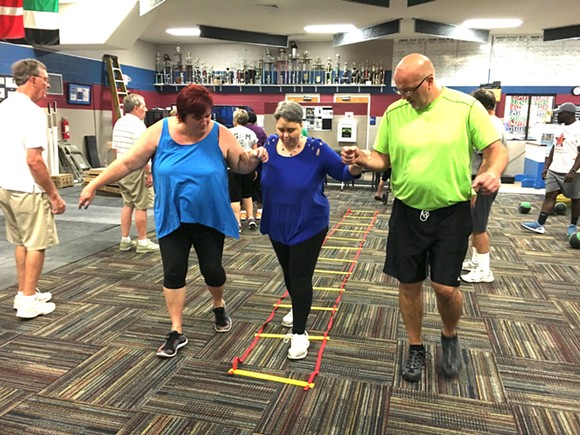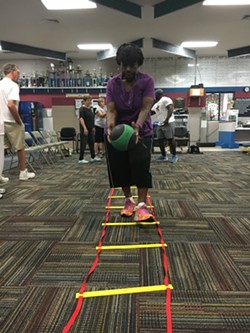WHEN Arlene Steinfeldt starts swinging, you’d better watch it.
The tiny septuagenarian has on a pair of blue and white boxing gloves, and nothing is going to stop her from smacking one of the heavy bags at the Anderson Cohen Weightlifting Center.
The fact that she’s in a wheelchair doesn’t keep her fists from pounding out a steady rhythm— thunk, kathunk thunk—as coach Gary Pauley shouts encouragement.
“Come on, hit me like you love me, Arlene!” Pauley hollers as she punches out one more combo.
As Steinfeldt is wheeled to the back of the line by caregiver Christy Pittman, another senior begins thwacking away. Pauley renews his cheers.
“Let’s go! Show me what ya got!”
The boxing drills are part of a recent program everyone here affectionately refers to as “GEM,” though the official name is Get Excited and Move. Also incorporating weights, stretching and agility work, it’s one of the first exercise programs especially designed to offset the tremors, imbalance and other symptoms brought on by Parkinson’s disease and other movement disorders.
“There is no cure for these conditions,” says Sarah Bernzott, executive director of the Savannah Parkinson’s Support Group. “The number one thing you can do is move.”
A vivacious redhead sporting electric blue nails, Bernzott has been facilitating the group for two years and recently decided that its attendees could use more than sedentary meet-ups. She began exploring exercise options at the county-owned gym off of Montgomery Cross Road, where former Olympic weightlifting champion Michael Cohen and his wife, Cheryl, run programming and direct team-oriented training. The Cohens—along with Michael’s father, the legendary Howard for whom the gym is partially named—have been passionate athletic advocates for decades, and they eagerly agreed to host.
Together, Bernzott and the Cohens considered one existing boxing program that targets Parkinson’s symptoms, but the training and licensing were cost-prohibitive. So Cohen, who is also the strength and conditioning coach for the US Paralympic Basketball team, came up with a custom workout based on current research that shows how exercise can help improve gait and balance in Parkinson’s as well as possibly slowing down the progression of the disease.
“We looked at the studies, and we knew we were one step ahead,” says Bernzott, adding that GEM participants include those living with Parkinson’s as well as multiple sclerosis, essential tremors and the aftermath of stroke.
“I’m not a scientist, but what we think is that certain neural pathways have become blocked, and that the movement helps the neurons take a new path.”
Whatever the mechanism, it’s working.
“We’ve had people who have been able to stop using their walkers after only a month,” reports Alice Gerber, who originated the Savannah Parkinson’s Support Group in the 1980s after her husband was diagnosed.
At 86, Gerber takes GEM classes herself, marveling at the progress made by people she has watched deteriorate from the neurological disorder. “It just makes me cry.”
Since its inception in February, GEM has grown from 23 participants to 142, and the current schedule bursts with 11 classes spread out over three days a week. Membership is $10 a month—half of the county’s regular dues—and participants can take as many classes as they want.
While the program’s popularity surely has to do with its affordability and accessibility, it may also have something to do with its availability to caregivers: Those who drive their loved ones or charges to the center are considered active GEM participants and receive the same coaching to help offset the physical and mental exhaustion that comes from the caretaking role.
“No other program in the country does that,” says Bernzott proudly.
GEM’s low-tech, affordable, inclusive approach is meant to be duplicated, and its implementation is already in progress at community centers on Tybee Island and Richmond Hill. Cohen will also share the details at the World Parkinson’s Congress in Oregon next month.
The GEM program may also provide insight through further scientific research: Armstrong State University Health Sciences professors Drs. David Hooper and Bryan Riemann will soon be conducting strength and balance assessments on participants along with Dr. Lesley Clack, who will examine the program from a psychosocial perspective. Eight graduate students from the sports medicine and health administration departments will help collect data from 60 to 65 participants, making it one of the largest longitudinal studies on Parkinson’s disease and exercise ever conducted.
Armstrong student Tommy Aluko volunteers several times a week with GEM as part of a gerontology internship and attests to its benefits.
“What it does is give people back their confidence. When people have the support, they’re willing to try, and then they come back because they improve,” says Aluko, echoing more stories of people who are able to leave their wheelchairs and walkers after a few weeks of regular participation.
“That isn’t anything a prescription can do.”
Coach Pauley announces the end of the boxing drill with an enthusiastic clap. The gloves come off and the group moves to the floor, where he leads them through a series of coordination exercises and stretches. Steinfeldt does them from her chair, and others set aside canes to sit on the carpet—a major feat for most seniors, let alone those dealing with neurological issues.
The gym walls are lined with the many trophies accrued by the Cohens and those they’ve coached, and the sparkling brass cups seem a fitting for backdrop for those whom it is a triumph just to be here.
Pauley, 53 and six-and-a-half feet tall with a boundless well of energy, has an easy rapport with the class and often sits in for Cohen when the busy sports coach isn’t available. An avid runner and former basketball referee, he also identifies as a “PWP”—a person with Parkinson’s.
Diagnosed in 2009, his doctor told him to stop exercising and “take it easy,” but Pauley knew that wasn’t an option. After receiving a deep brain stimulator that helped with the tremors, he was able to resume a running schedule and finished last year’s Savannah Mile in eighth place for his age group.
He began with GEM as a participant and quickly became a leader in this community that supports building strength, no matter what the prognosis.
“Here, we’re not treated as patients,” he says, signaling for everyone to touch their toes.
“We’re treated like athletes.”




